Analysis of Doueihi V Construction Technologies in Commercial Law
VerifiedAdded on 2023/06/05
|10
|2715
|389
Case Study
AI Summary
This case study provides an in-depth analysis of Doueihi V Construction Technologies Australia Pty Ltd (2016) NSWCA 105, focusing on the legal principles of equitable estoppel and its application in commercial law. The case revolves around a property purchase and lease agreement dispute involving family members and their associated businesses, highlighting the complexities of informal agreements and the importance of equitable remedies when formal contracts are lacking. The initial court decision favored Construction Technology Australia Pty Ltd (CTA), establishing equitable estoppel due to the co-owners' encouragement of CTA's reliance on a lease agreement. The appeal upheld this decision, emphasizing the significance of tangible rights and the unconscionability of departing from established assumptions. The study further explores the concepts of promissory estoppel, comparing the case to Waltons Stores Ltd v Maher, and underscores the role of equity in preventing unjust outcomes when strict application of statutes, such as the Statute of Frauds, may lead to unfair results. The analysis details the judgments, ratio decidendi, and orbiter dictum, offering a comprehensive understanding of the case's legal implications and its importance in protecting parties relying on oral agreements and detrimental actions.
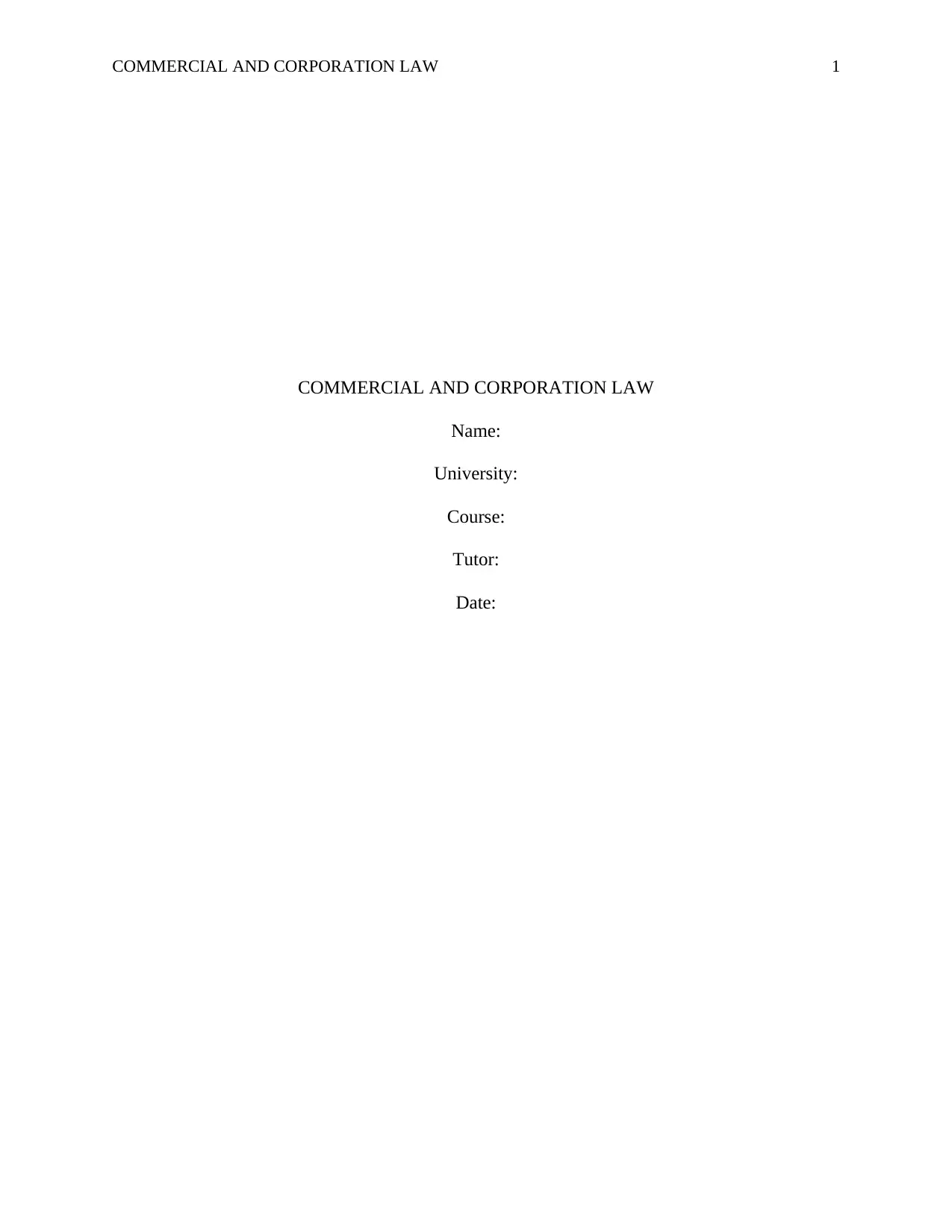
COMMERCIAL AND CORPORATION LAW 1
COMMERCIAL AND CORPORATION LAW
Name:
University:
Course:
Tutor:
Date:
COMMERCIAL AND CORPORATION LAW
Name:
University:
Course:
Tutor:
Date:
Paraphrase This Document
Need a fresh take? Get an instant paraphrase of this document with our AI Paraphraser
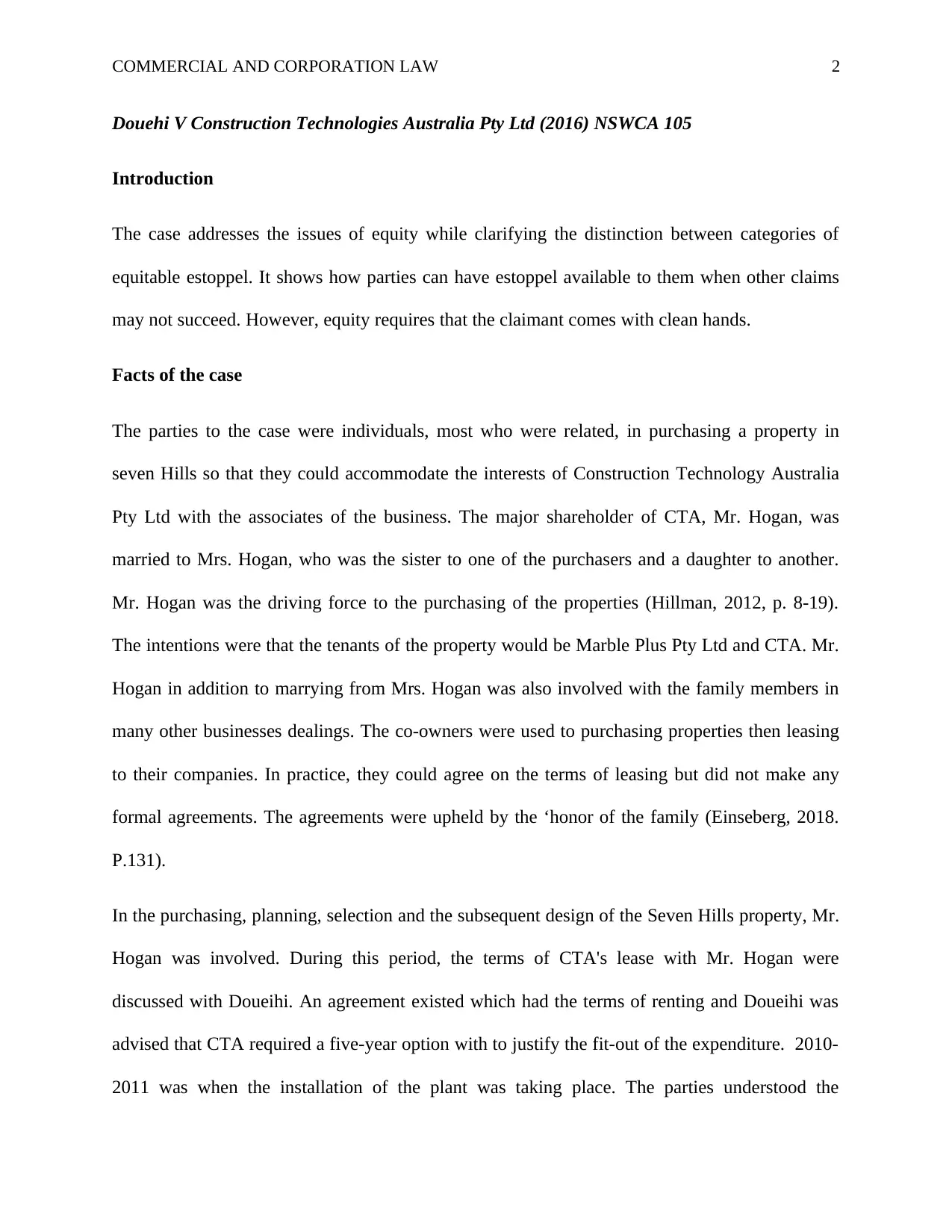
COMMERCIAL AND CORPORATION LAW 2
Douehi V Construction Technologies Australia Pty Ltd (2016) NSWCA 105
Introduction
The case addresses the issues of equity while clarifying the distinction between categories of
equitable estoppel. It shows how parties can have estoppel available to them when other claims
may not succeed. However, equity requires that the claimant comes with clean hands.
Facts of the case
The parties to the case were individuals, most who were related, in purchasing a property in
seven Hills so that they could accommodate the interests of Construction Technology Australia
Pty Ltd with the associates of the business. The major shareholder of CTA, Mr. Hogan, was
married to Mrs. Hogan, who was the sister to one of the purchasers and a daughter to another.
Mr. Hogan was the driving force to the purchasing of the properties (Hillman, 2012, p. 8-19).
The intentions were that the tenants of the property would be Marble Plus Pty Ltd and CTA. Mr.
Hogan in addition to marrying from Mrs. Hogan was also involved with the family members in
many other businesses dealings. The co-owners were used to purchasing properties then leasing
to their companies. In practice, they could agree on the terms of leasing but did not make any
formal agreements. The agreements were upheld by the ‘honor of the family (Einseberg, 2018.
P.131).
In the purchasing, planning, selection and the subsequent design of the Seven Hills property, Mr.
Hogan was involved. During this period, the terms of CTA's lease with Mr. Hogan were
discussed with Doueihi. An agreement existed which had the terms of renting and Doueihi was
advised that CTA required a five-year option with to justify the fit-out of the expenditure. 2010-
2011 was when the installation of the plant was taking place. The parties understood the
Douehi V Construction Technologies Australia Pty Ltd (2016) NSWCA 105
Introduction
The case addresses the issues of equity while clarifying the distinction between categories of
equitable estoppel. It shows how parties can have estoppel available to them when other claims
may not succeed. However, equity requires that the claimant comes with clean hands.
Facts of the case
The parties to the case were individuals, most who were related, in purchasing a property in
seven Hills so that they could accommodate the interests of Construction Technology Australia
Pty Ltd with the associates of the business. The major shareholder of CTA, Mr. Hogan, was
married to Mrs. Hogan, who was the sister to one of the purchasers and a daughter to another.
Mr. Hogan was the driving force to the purchasing of the properties (Hillman, 2012, p. 8-19).
The intentions were that the tenants of the property would be Marble Plus Pty Ltd and CTA. Mr.
Hogan in addition to marrying from Mrs. Hogan was also involved with the family members in
many other businesses dealings. The co-owners were used to purchasing properties then leasing
to their companies. In practice, they could agree on the terms of leasing but did not make any
formal agreements. The agreements were upheld by the ‘honor of the family (Einseberg, 2018.
P.131).
In the purchasing, planning, selection and the subsequent design of the Seven Hills property, Mr.
Hogan was involved. During this period, the terms of CTA's lease with Mr. Hogan were
discussed with Doueihi. An agreement existed which had the terms of renting and Doueihi was
advised that CTA required a five-year option with to justify the fit-out of the expenditure. 2010-
2011 was when the installation of the plant was taking place. The parties understood the
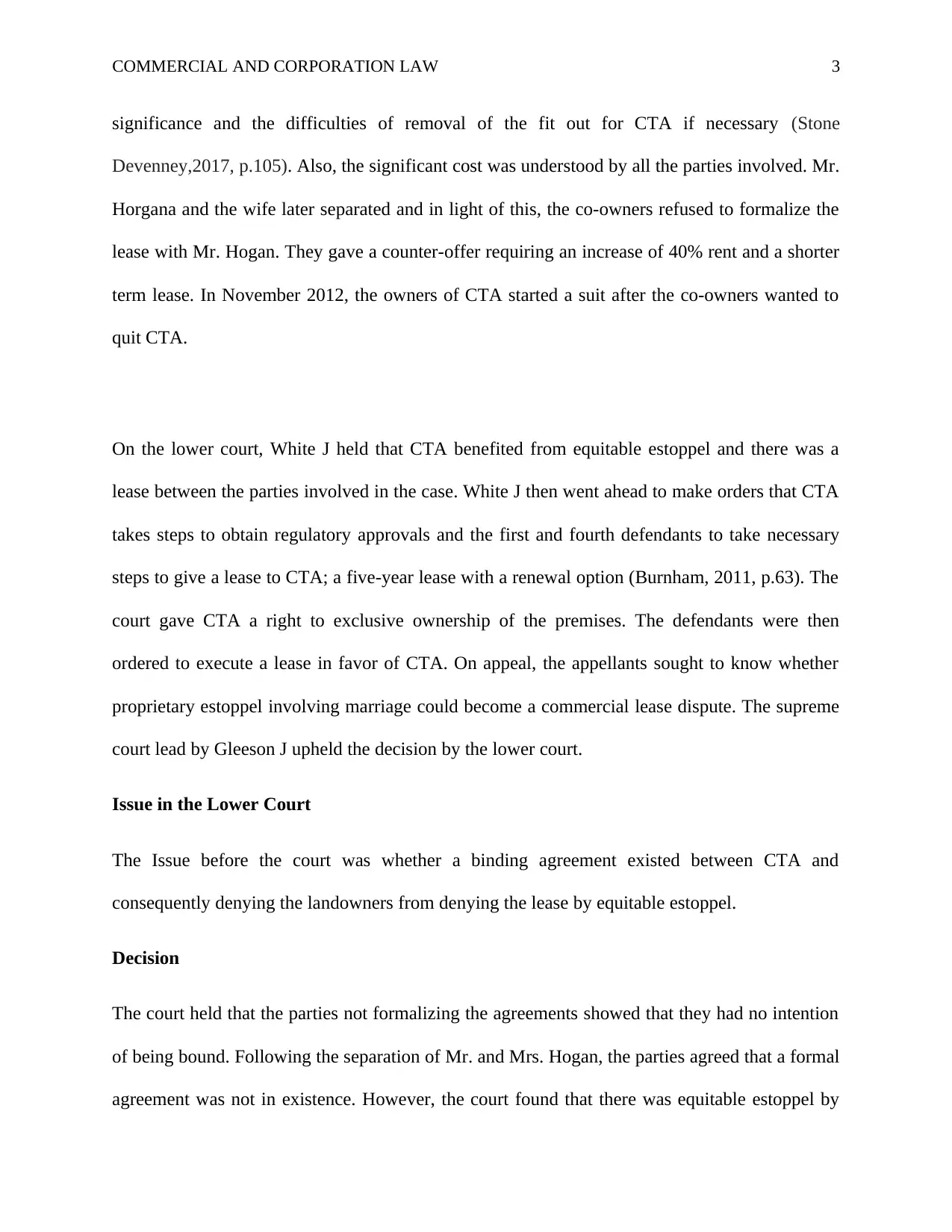
COMMERCIAL AND CORPORATION LAW 3
significance and the difficulties of removal of the fit out for CTA if necessary (Stone
Devenney,2017, p.105). Also, the significant cost was understood by all the parties involved. Mr.
Horgana and the wife later separated and in light of this, the co-owners refused to formalize the
lease with Mr. Hogan. They gave a counter-offer requiring an increase of 40% rent and a shorter
term lease. In November 2012, the owners of CTA started a suit after the co-owners wanted to
quit CTA.
On the lower court, White J held that CTA benefited from equitable estoppel and there was a
lease between the parties involved in the case. White J then went ahead to make orders that CTA
takes steps to obtain regulatory approvals and the first and fourth defendants to take necessary
steps to give a lease to CTA; a five-year lease with a renewal option (Burnham, 2011, p.63). The
court gave CTA a right to exclusive ownership of the premises. The defendants were then
ordered to execute a lease in favor of CTA. On appeal, the appellants sought to know whether
proprietary estoppel involving marriage could become a commercial lease dispute. The supreme
court lead by Gleeson J upheld the decision by the lower court.
Issue in the Lower Court
The Issue before the court was whether a binding agreement existed between CTA and
consequently denying the landowners from denying the lease by equitable estoppel.
Decision
The court held that the parties not formalizing the agreements showed that they had no intention
of being bound. Following the separation of Mr. and Mrs. Hogan, the parties agreed that a formal
agreement was not in existence. However, the court found that there was equitable estoppel by
significance and the difficulties of removal of the fit out for CTA if necessary (Stone
Devenney,2017, p.105). Also, the significant cost was understood by all the parties involved. Mr.
Horgana and the wife later separated and in light of this, the co-owners refused to formalize the
lease with Mr. Hogan. They gave a counter-offer requiring an increase of 40% rent and a shorter
term lease. In November 2012, the owners of CTA started a suit after the co-owners wanted to
quit CTA.
On the lower court, White J held that CTA benefited from equitable estoppel and there was a
lease between the parties involved in the case. White J then went ahead to make orders that CTA
takes steps to obtain regulatory approvals and the first and fourth defendants to take necessary
steps to give a lease to CTA; a five-year lease with a renewal option (Burnham, 2011, p.63). The
court gave CTA a right to exclusive ownership of the premises. The defendants were then
ordered to execute a lease in favor of CTA. On appeal, the appellants sought to know whether
proprietary estoppel involving marriage could become a commercial lease dispute. The supreme
court lead by Gleeson J upheld the decision by the lower court.
Issue in the Lower Court
The Issue before the court was whether a binding agreement existed between CTA and
consequently denying the landowners from denying the lease by equitable estoppel.
Decision
The court held that the parties not formalizing the agreements showed that they had no intention
of being bound. Following the separation of Mr. and Mrs. Hogan, the parties agreed that a formal
agreement was not in existence. However, the court found that there was equitable estoppel by
⊘ This is a preview!⊘
Do you want full access?
Subscribe today to unlock all pages.

Trusted by 1+ million students worldwide
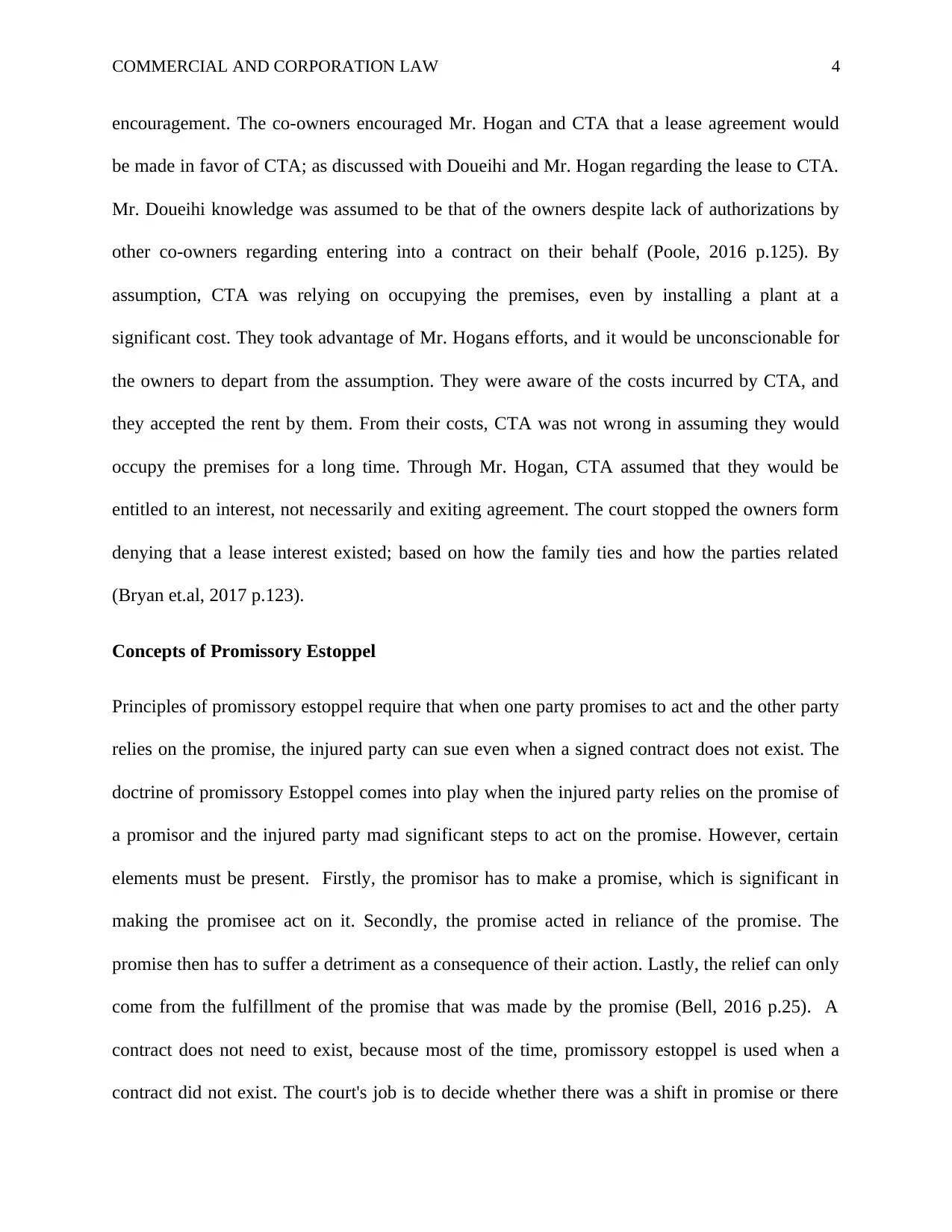
COMMERCIAL AND CORPORATION LAW 4
encouragement. The co-owners encouraged Mr. Hogan and CTA that a lease agreement would
be made in favor of CTA; as discussed with Doueihi and Mr. Hogan regarding the lease to CTA.
Mr. Doueihi knowledge was assumed to be that of the owners despite lack of authorizations by
other co-owners regarding entering into a contract on their behalf (Poole, 2016 p.125). By
assumption, CTA was relying on occupying the premises, even by installing a plant at a
significant cost. They took advantage of Mr. Hogans efforts, and it would be unconscionable for
the owners to depart from the assumption. They were aware of the costs incurred by CTA, and
they accepted the rent by them. From their costs, CTA was not wrong in assuming they would
occupy the premises for a long time. Through Mr. Hogan, CTA assumed that they would be
entitled to an interest, not necessarily and exiting agreement. The court stopped the owners form
denying that a lease interest existed; based on how the family ties and how the parties related
(Bryan et.al, 2017 p.123).
Concepts of Promissory Estoppel
Principles of promissory estoppel require that when one party promises to act and the other party
relies on the promise, the injured party can sue even when a signed contract does not exist. The
doctrine of promissory Estoppel comes into play when the injured party relies on the promise of
a promisor and the injured party mad significant steps to act on the promise. However, certain
elements must be present. Firstly, the promisor has to make a promise, which is significant in
making the promisee act on it. Secondly, the promise acted in reliance of the promise. The
promise then has to suffer a detriment as a consequence of their action. Lastly, the relief can only
come from the fulfillment of the promise that was made by the promise (Bell, 2016 p.25). A
contract does not need to exist, because most of the time, promissory estoppel is used when a
contract did not exist. The court's job is to decide whether there was a shift in promise or there
encouragement. The co-owners encouraged Mr. Hogan and CTA that a lease agreement would
be made in favor of CTA; as discussed with Doueihi and Mr. Hogan regarding the lease to CTA.
Mr. Doueihi knowledge was assumed to be that of the owners despite lack of authorizations by
other co-owners regarding entering into a contract on their behalf (Poole, 2016 p.125). By
assumption, CTA was relying on occupying the premises, even by installing a plant at a
significant cost. They took advantage of Mr. Hogans efforts, and it would be unconscionable for
the owners to depart from the assumption. They were aware of the costs incurred by CTA, and
they accepted the rent by them. From their costs, CTA was not wrong in assuming they would
occupy the premises for a long time. Through Mr. Hogan, CTA assumed that they would be
entitled to an interest, not necessarily and exiting agreement. The court stopped the owners form
denying that a lease interest existed; based on how the family ties and how the parties related
(Bryan et.al, 2017 p.123).
Concepts of Promissory Estoppel
Principles of promissory estoppel require that when one party promises to act and the other party
relies on the promise, the injured party can sue even when a signed contract does not exist. The
doctrine of promissory Estoppel comes into play when the injured party relies on the promise of
a promisor and the injured party mad significant steps to act on the promise. However, certain
elements must be present. Firstly, the promisor has to make a promise, which is significant in
making the promisee act on it. Secondly, the promise acted in reliance of the promise. The
promise then has to suffer a detriment as a consequence of their action. Lastly, the relief can only
come from the fulfillment of the promise that was made by the promise (Bell, 2016 p.25). A
contract does not need to exist, because most of the time, promissory estoppel is used when a
contract did not exist. The court's job is to decide whether there was a shift in promise or there
Paraphrase This Document
Need a fresh take? Get an instant paraphrase of this document with our AI Paraphraser
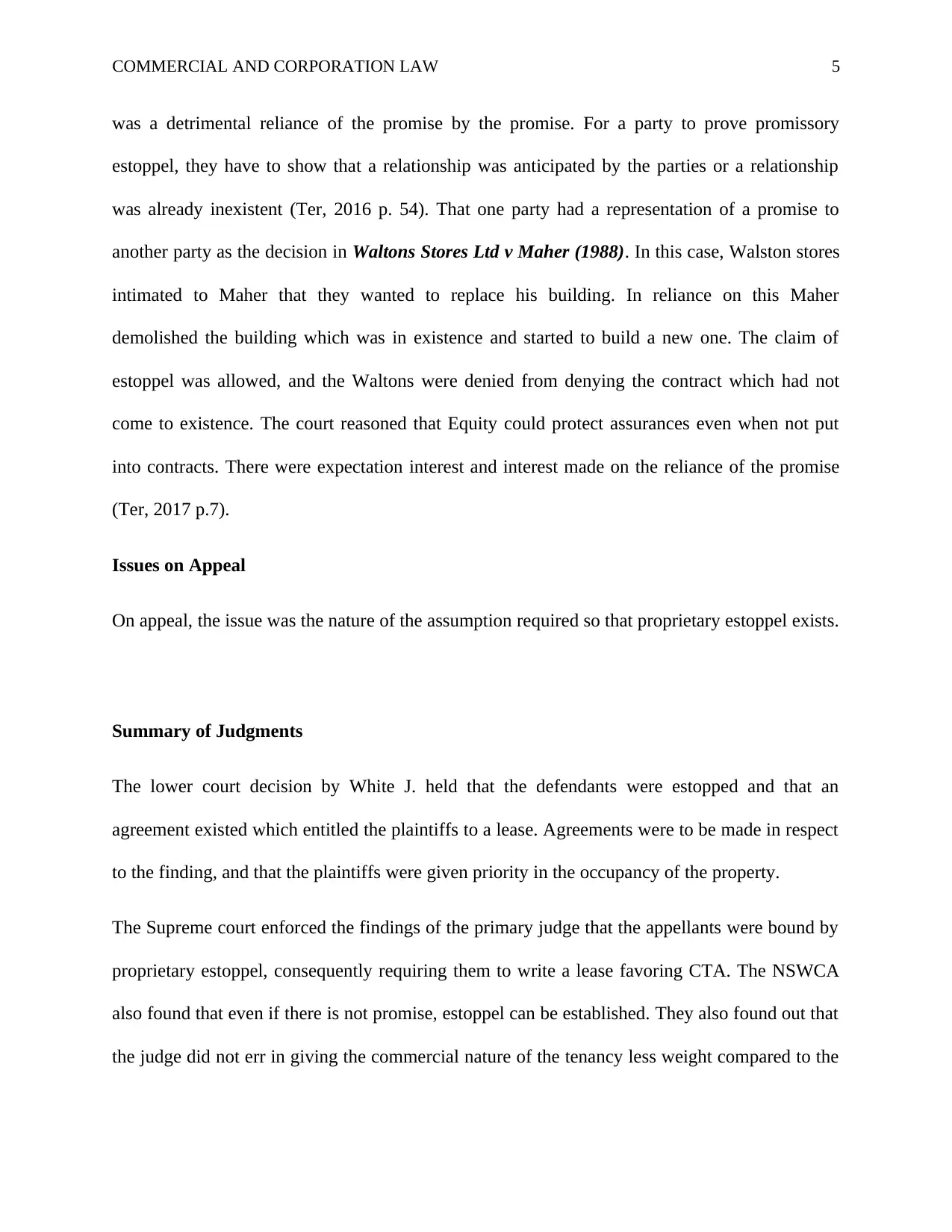
COMMERCIAL AND CORPORATION LAW 5
was a detrimental reliance of the promise by the promise. For a party to prove promissory
estoppel, they have to show that a relationship was anticipated by the parties or a relationship
was already inexistent (Ter, 2016 p. 54). That one party had a representation of a promise to
another party as the decision in Waltons Stores Ltd v Maher (1988). In this case, Walston stores
intimated to Maher that they wanted to replace his building. In reliance on this Maher
demolished the building which was in existence and started to build a new one. The claim of
estoppel was allowed, and the Waltons were denied from denying the contract which had not
come to existence. The court reasoned that Equity could protect assurances even when not put
into contracts. There were expectation interest and interest made on the reliance of the promise
(Ter, 2017 p.7).
Issues on Appeal
On appeal, the issue was the nature of the assumption required so that proprietary estoppel exists.
Summary of Judgments
The lower court decision by White J. held that the defendants were estopped and that an
agreement existed which entitled the plaintiffs to a lease. Agreements were to be made in respect
to the finding, and that the plaintiffs were given priority in the occupancy of the property.
The Supreme court enforced the findings of the primary judge that the appellants were bound by
proprietary estoppel, consequently requiring them to write a lease favoring CTA. The NSWCA
also found that even if there is not promise, estoppel can be established. They also found out that
the judge did not err in giving the commercial nature of the tenancy less weight compared to the
was a detrimental reliance of the promise by the promise. For a party to prove promissory
estoppel, they have to show that a relationship was anticipated by the parties or a relationship
was already inexistent (Ter, 2016 p. 54). That one party had a representation of a promise to
another party as the decision in Waltons Stores Ltd v Maher (1988). In this case, Walston stores
intimated to Maher that they wanted to replace his building. In reliance on this Maher
demolished the building which was in existence and started to build a new one. The claim of
estoppel was allowed, and the Waltons were denied from denying the contract which had not
come to existence. The court reasoned that Equity could protect assurances even when not put
into contracts. There were expectation interest and interest made on the reliance of the promise
(Ter, 2017 p.7).
Issues on Appeal
On appeal, the issue was the nature of the assumption required so that proprietary estoppel exists.
Summary of Judgments
The lower court decision by White J. held that the defendants were estopped and that an
agreement existed which entitled the plaintiffs to a lease. Agreements were to be made in respect
to the finding, and that the plaintiffs were given priority in the occupancy of the property.
The Supreme court enforced the findings of the primary judge that the appellants were bound by
proprietary estoppel, consequently requiring them to write a lease favoring CTA. The NSWCA
also found that even if there is not promise, estoppel can be established. They also found out that
the judge did not err in giving the commercial nature of the tenancy less weight compared to the

COMMERCIAL AND CORPORATION LAW 6
family context in the assessment of assurance given to CTA reliance that interest would be
granted even without the existence of a formal lease (Chern, 2011 p.3).
Ratio Decidendi- Orbiter Dictum
White J gave the decision on the basis that the defendants encouraged Hogan, thus an assumption
that interest would be granted existed. The defendants also encouraged the adoption of the
assumptions when Doueihis terms of CTA's occupation were accepted (Seragant, 2015, p.24).
The court also considered the fact that it would be expensive for Hogan to remove all the
installations, and that he had invested in the planning, construction and monitoring the premises.
It was, therefore, unconscionable for the defendants to deny Hogan the right of occupations after
he invested his resources and effort on the premises. Mr. Doueihis acquiescence in the
occupation of the property was also not challenged by the defendants, and he agreed with the
defendants with Hogan's knowledge. White J also considered the findings in the case of
Giumelli v Giumelli, stating that equitable estoppel is distinct from contractual obligations in
that in estoppel, there is no legally binding promise. Also, in estoppel, the expectation creates the
promissory estoppel. Thirdly, the expectation in equity is created by the conduct of the plaintiff
in acting upon the promise. Therefore, an agreement in principle is sufficient to prove equitable
estoppel and not necessarily the existence of a binding contract. This case also underscores
difficulties which parties can face when trying to establish estoppel as seen in the case of
Waltons.
White J considered the tests established in Waltons and giving a broader test as set out by Wilson
J and Mason J. The narrower test having being set out by Brennan J. White J stated that the
family context in the assessment of assurance given to CTA reliance that interest would be
granted even without the existence of a formal lease (Chern, 2011 p.3).
Ratio Decidendi- Orbiter Dictum
White J gave the decision on the basis that the defendants encouraged Hogan, thus an assumption
that interest would be granted existed. The defendants also encouraged the adoption of the
assumptions when Doueihis terms of CTA's occupation were accepted (Seragant, 2015, p.24).
The court also considered the fact that it would be expensive for Hogan to remove all the
installations, and that he had invested in the planning, construction and monitoring the premises.
It was, therefore, unconscionable for the defendants to deny Hogan the right of occupations after
he invested his resources and effort on the premises. Mr. Doueihis acquiescence in the
occupation of the property was also not challenged by the defendants, and he agreed with the
defendants with Hogan's knowledge. White J also considered the findings in the case of
Giumelli v Giumelli, stating that equitable estoppel is distinct from contractual obligations in
that in estoppel, there is no legally binding promise. Also, in estoppel, the expectation creates the
promissory estoppel. Thirdly, the expectation in equity is created by the conduct of the plaintiff
in acting upon the promise. Therefore, an agreement in principle is sufficient to prove equitable
estoppel and not necessarily the existence of a binding contract. This case also underscores
difficulties which parties can face when trying to establish estoppel as seen in the case of
Waltons.
White J considered the tests established in Waltons and giving a broader test as set out by Wilson
J and Mason J. The narrower test having being set out by Brennan J. White J stated that the
⊘ This is a preview!⊘
Do you want full access?
Subscribe today to unlock all pages.

Trusted by 1+ million students worldwide
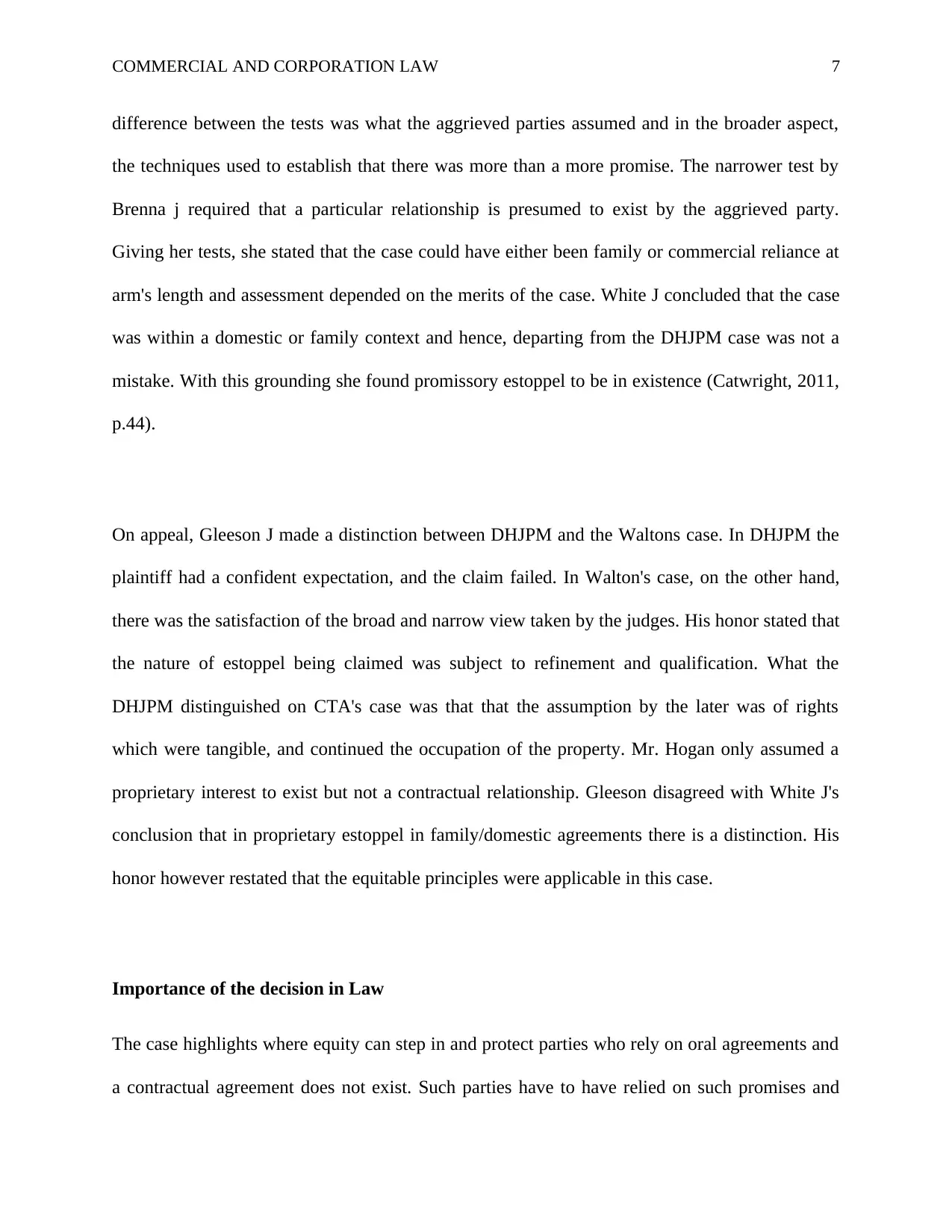
COMMERCIAL AND CORPORATION LAW 7
difference between the tests was what the aggrieved parties assumed and in the broader aspect,
the techniques used to establish that there was more than a more promise. The narrower test by
Brenna j required that a particular relationship is presumed to exist by the aggrieved party.
Giving her tests, she stated that the case could have either been family or commercial reliance at
arm's length and assessment depended on the merits of the case. White J concluded that the case
was within a domestic or family context and hence, departing from the DHJPM case was not a
mistake. With this grounding she found promissory estoppel to be in existence (Catwright, 2011,
p.44).
On appeal, Gleeson J made a distinction between DHJPM and the Waltons case. In DHJPM the
plaintiff had a confident expectation, and the claim failed. In Walton's case, on the other hand,
there was the satisfaction of the broad and narrow view taken by the judges. His honor stated that
the nature of estoppel being claimed was subject to refinement and qualification. What the
DHJPM distinguished on CTA's case was that that the assumption by the later was of rights
which were tangible, and continued the occupation of the property. Mr. Hogan only assumed a
proprietary interest to exist but not a contractual relationship. Gleeson disagreed with White J's
conclusion that in proprietary estoppel in family/domestic agreements there is a distinction. His
honor however restated that the equitable principles were applicable in this case.
Importance of the decision in Law
The case highlights where equity can step in and protect parties who rely on oral agreements and
a contractual agreement does not exist. Such parties have to have relied on such promises and
difference between the tests was what the aggrieved parties assumed and in the broader aspect,
the techniques used to establish that there was more than a more promise. The narrower test by
Brenna j required that a particular relationship is presumed to exist by the aggrieved party.
Giving her tests, she stated that the case could have either been family or commercial reliance at
arm's length and assessment depended on the merits of the case. White J concluded that the case
was within a domestic or family context and hence, departing from the DHJPM case was not a
mistake. With this grounding she found promissory estoppel to be in existence (Catwright, 2011,
p.44).
On appeal, Gleeson J made a distinction between DHJPM and the Waltons case. In DHJPM the
plaintiff had a confident expectation, and the claim failed. In Walton's case, on the other hand,
there was the satisfaction of the broad and narrow view taken by the judges. His honor stated that
the nature of estoppel being claimed was subject to refinement and qualification. What the
DHJPM distinguished on CTA's case was that that the assumption by the later was of rights
which were tangible, and continued the occupation of the property. Mr. Hogan only assumed a
proprietary interest to exist but not a contractual relationship. Gleeson disagreed with White J's
conclusion that in proprietary estoppel in family/domestic agreements there is a distinction. His
honor however restated that the equitable principles were applicable in this case.
Importance of the decision in Law
The case highlights where equity can step in and protect parties who rely on oral agreements and
a contractual agreement does not exist. Such parties have to have relied on such promises and
Paraphrase This Document
Need a fresh take? Get an instant paraphrase of this document with our AI Paraphraser
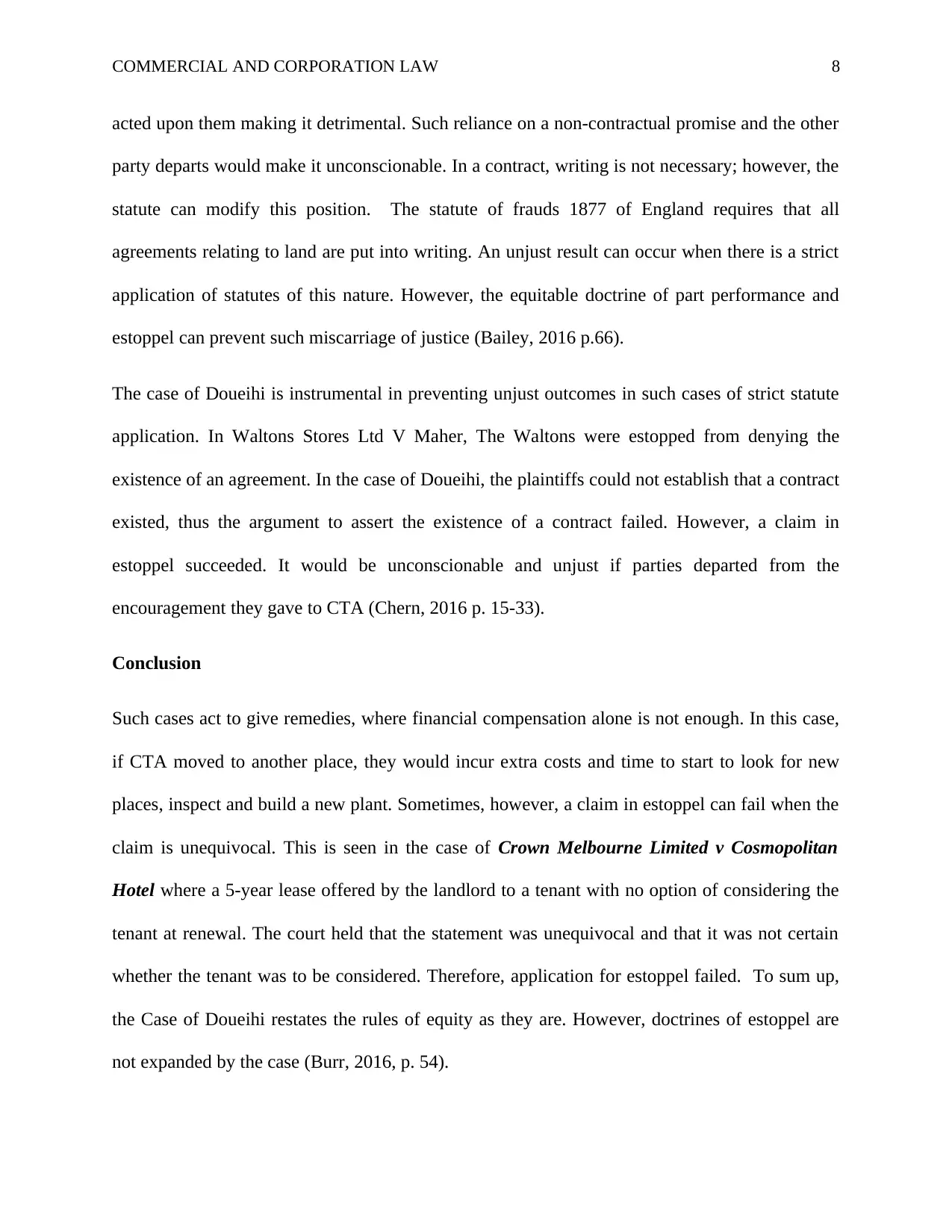
COMMERCIAL AND CORPORATION LAW 8
acted upon them making it detrimental. Such reliance on a non-contractual promise and the other
party departs would make it unconscionable. In a contract, writing is not necessary; however, the
statute can modify this position. The statute of frauds 1877 of England requires that all
agreements relating to land are put into writing. An unjust result can occur when there is a strict
application of statutes of this nature. However, the equitable doctrine of part performance and
estoppel can prevent such miscarriage of justice (Bailey, 2016 p.66).
The case of Doueihi is instrumental in preventing unjust outcomes in such cases of strict statute
application. In Waltons Stores Ltd V Maher, The Waltons were estopped from denying the
existence of an agreement. In the case of Doueihi, the plaintiffs could not establish that a contract
existed, thus the argument to assert the existence of a contract failed. However, a claim in
estoppel succeeded. It would be unconscionable and unjust if parties departed from the
encouragement they gave to CTA (Chern, 2016 p. 15-33).
Conclusion
Such cases act to give remedies, where financial compensation alone is not enough. In this case,
if CTA moved to another place, they would incur extra costs and time to start to look for new
places, inspect and build a new plant. Sometimes, however, a claim in estoppel can fail when the
claim is unequivocal. This is seen in the case of Crown Melbourne Limited v Cosmopolitan
Hotel where a 5-year lease offered by the landlord to a tenant with no option of considering the
tenant at renewal. The court held that the statement was unequivocal and that it was not certain
whether the tenant was to be considered. Therefore, application for estoppel failed. To sum up,
the Case of Doueihi restates the rules of equity as they are. However, doctrines of estoppel are
not expanded by the case (Burr, 2016, p. 54).
acted upon them making it detrimental. Such reliance on a non-contractual promise and the other
party departs would make it unconscionable. In a contract, writing is not necessary; however, the
statute can modify this position. The statute of frauds 1877 of England requires that all
agreements relating to land are put into writing. An unjust result can occur when there is a strict
application of statutes of this nature. However, the equitable doctrine of part performance and
estoppel can prevent such miscarriage of justice (Bailey, 2016 p.66).
The case of Doueihi is instrumental in preventing unjust outcomes in such cases of strict statute
application. In Waltons Stores Ltd V Maher, The Waltons were estopped from denying the
existence of an agreement. In the case of Doueihi, the plaintiffs could not establish that a contract
existed, thus the argument to assert the existence of a contract failed. However, a claim in
estoppel succeeded. It would be unconscionable and unjust if parties departed from the
encouragement they gave to CTA (Chern, 2016 p. 15-33).
Conclusion
Such cases act to give remedies, where financial compensation alone is not enough. In this case,
if CTA moved to another place, they would incur extra costs and time to start to look for new
places, inspect and build a new plant. Sometimes, however, a claim in estoppel can fail when the
claim is unequivocal. This is seen in the case of Crown Melbourne Limited v Cosmopolitan
Hotel where a 5-year lease offered by the landlord to a tenant with no option of considering the
tenant at renewal. The court held that the statement was unequivocal and that it was not certain
whether the tenant was to be considered. Therefore, application for estoppel failed. To sum up,
the Case of Doueihi restates the rules of equity as they are. However, doctrines of estoppel are
not expanded by the case (Burr, 2016, p. 54).
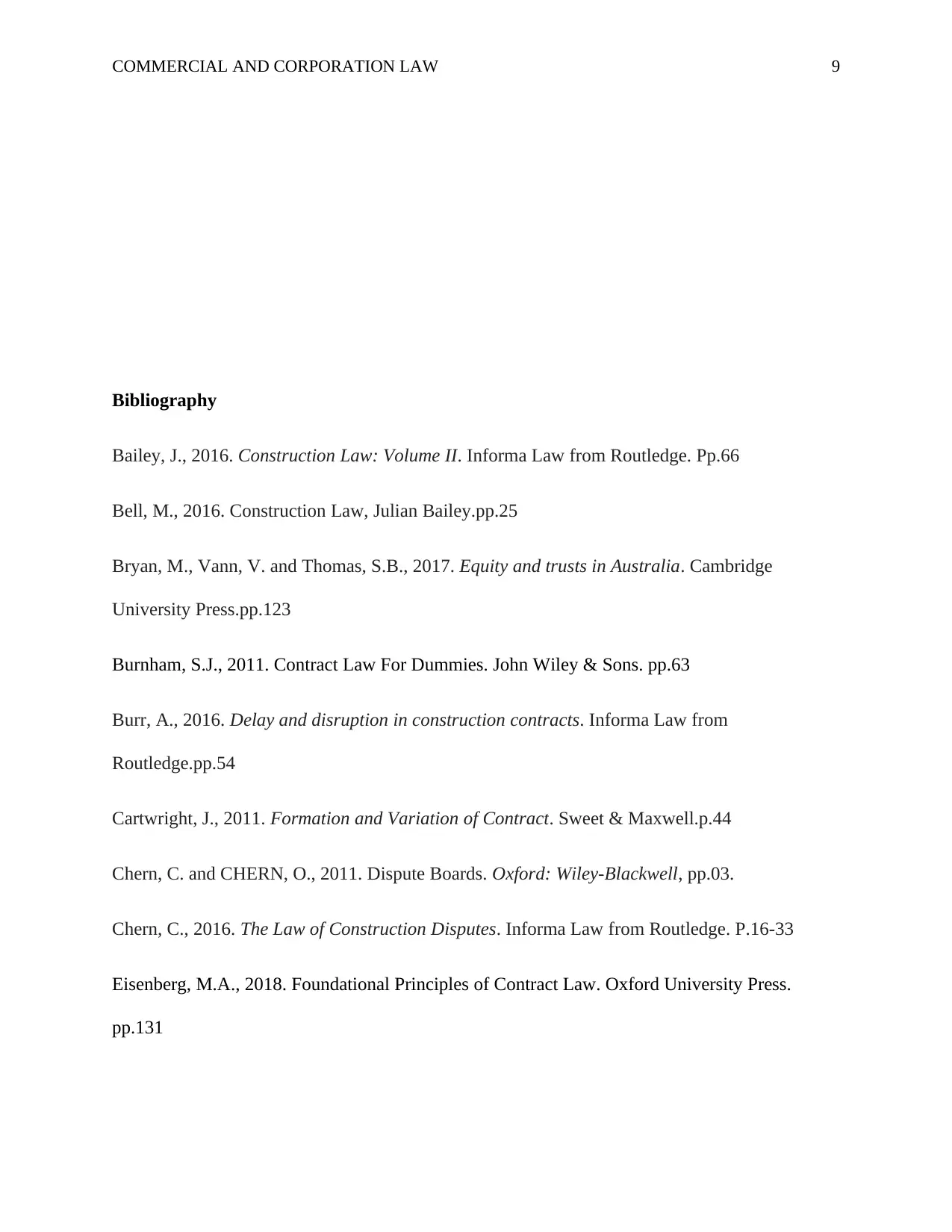
COMMERCIAL AND CORPORATION LAW 9
Bibliography
Bailey, J., 2016. Construction Law: Volume II. Informa Law from Routledge. Pp.66
Bell, M., 2016. Construction Law, Julian Bailey.pp.25
Bryan, M., Vann, V. and Thomas, S.B., 2017. Equity and trusts in Australia. Cambridge
University Press.pp.123
Burnham, S.J., 2011. Contract Law For Dummies. John Wiley & Sons. pp.63
Burr, A., 2016. Delay and disruption in construction contracts. Informa Law from
Routledge.pp.54
Cartwright, J., 2011. Formation and Variation of Contract. Sweet & Maxwell.p.44
Chern, C. and CHERN, O., 2011. Dispute Boards. Oxford: Wiley-Blackwell, pp.03.
Chern, C., 2016. The Law of Construction Disputes. Informa Law from Routledge. P.16-33
Eisenberg, M.A., 2018. Foundational Principles of Contract Law. Oxford University Press.
pp.131
Bibliography
Bailey, J., 2016. Construction Law: Volume II. Informa Law from Routledge. Pp.66
Bell, M., 2016. Construction Law, Julian Bailey.pp.25
Bryan, M., Vann, V. and Thomas, S.B., 2017. Equity and trusts in Australia. Cambridge
University Press.pp.123
Burnham, S.J., 2011. Contract Law For Dummies. John Wiley & Sons. pp.63
Burr, A., 2016. Delay and disruption in construction contracts. Informa Law from
Routledge.pp.54
Cartwright, J., 2011. Formation and Variation of Contract. Sweet & Maxwell.p.44
Chern, C. and CHERN, O., 2011. Dispute Boards. Oxford: Wiley-Blackwell, pp.03.
Chern, C., 2016. The Law of Construction Disputes. Informa Law from Routledge. P.16-33
Eisenberg, M.A., 2018. Foundational Principles of Contract Law. Oxford University Press.
pp.131
⊘ This is a preview!⊘
Do you want full access?
Subscribe today to unlock all pages.

Trusted by 1+ million students worldwide
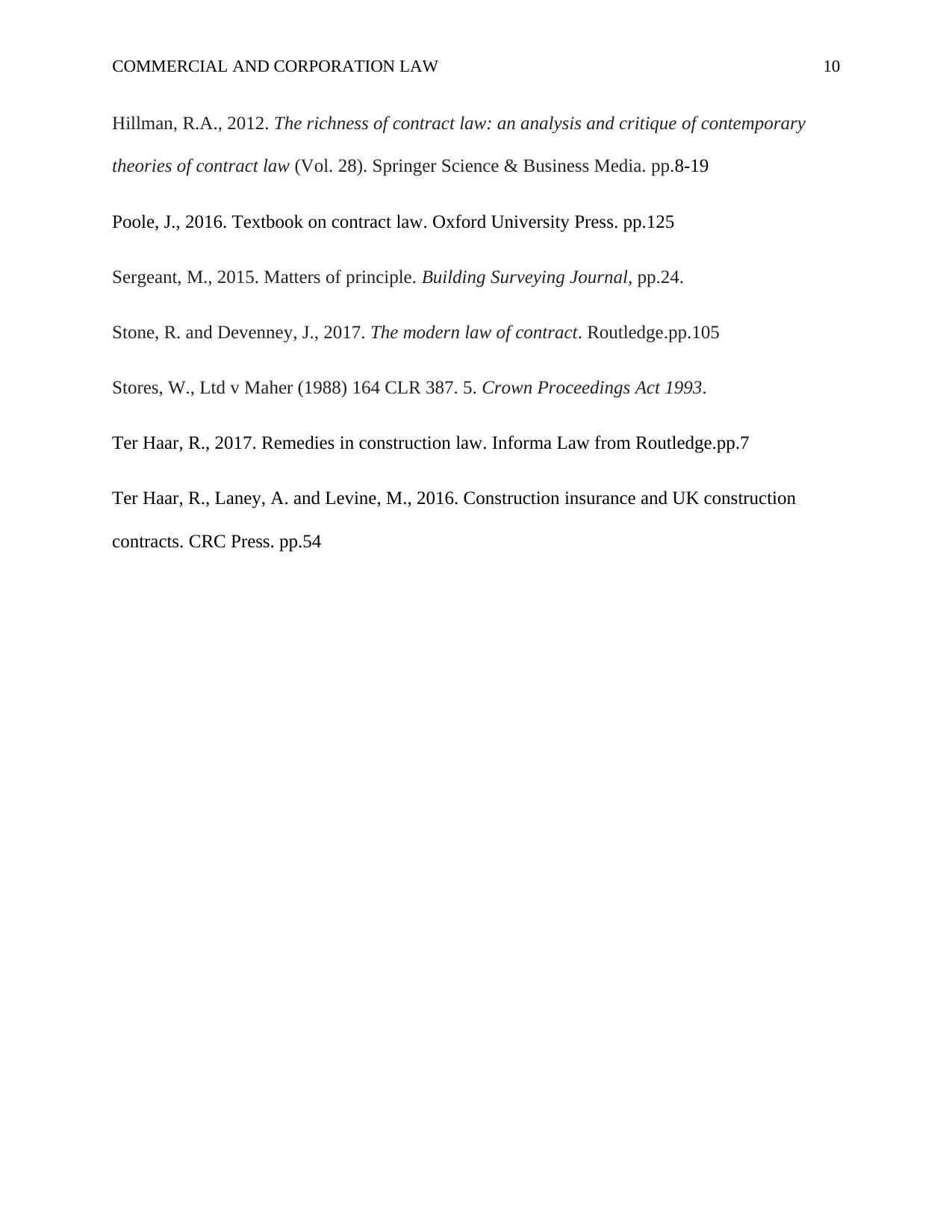
COMMERCIAL AND CORPORATION LAW 10
Hillman, R.A., 2012. The richness of contract law: an analysis and critique of contemporary
theories of contract law (Vol. 28). Springer Science & Business Media. pp.8-19
Poole, J., 2016. Textbook on contract law. Oxford University Press. pp.125
Sergeant, M., 2015. Matters of principle. Building Surveying Journal, pp.24.
Stone, R. and Devenney, J., 2017. The modern law of contract. Routledge.pp.105
Stores, W., Ltd v Maher (1988) 164 CLR 387. 5. Crown Proceedings Act 1993.
Ter Haar, R., 2017. Remedies in construction law. Informa Law from Routledge.pp.7
Ter Haar, R., Laney, A. and Levine, M., 2016. Construction insurance and UK construction
contracts. CRC Press. pp.54
Hillman, R.A., 2012. The richness of contract law: an analysis and critique of contemporary
theories of contract law (Vol. 28). Springer Science & Business Media. pp.8-19
Poole, J., 2016. Textbook on contract law. Oxford University Press. pp.125
Sergeant, M., 2015. Matters of principle. Building Surveying Journal, pp.24.
Stone, R. and Devenney, J., 2017. The modern law of contract. Routledge.pp.105
Stores, W., Ltd v Maher (1988) 164 CLR 387. 5. Crown Proceedings Act 1993.
Ter Haar, R., 2017. Remedies in construction law. Informa Law from Routledge.pp.7
Ter Haar, R., Laney, A. and Levine, M., 2016. Construction insurance and UK construction
contracts. CRC Press. pp.54
1 out of 10
Your All-in-One AI-Powered Toolkit for Academic Success.
+13062052269
info@desklib.com
Available 24*7 on WhatsApp / Email
![[object Object]](/_next/static/media/star-bottom.7253800d.svg)
Unlock your academic potential
Copyright © 2020–2025 A2Z Services. All Rights Reserved. Developed and managed by ZUCOL.

